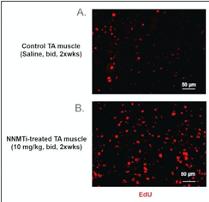Small Molecule Enhancing NAD+ Levels Rejuvenates Muscles
A small molecule inhibitor of an enzyme called NNMT improved aged mice's muscle quality and function. In the future, the drug might help the elders feel fitter and stronger.

Previous research indicated reduced levels of the molecule, nicotinamide adenine dinucleotide (NAD+), in the body with age contribute to dysfunctional skeletal muscle metabolism and inhibited function of the muscle cell’s powerhouse, the mitochondria. This leads to muscle degeneration and loss of muscle function with age, along with impaired muscle repair.
With this in mind, scientists from the University of Texas Medical Branch (UTMB) set out to find interventions to improve muscle function in older animals, mice in this case. They published their study of the effects of the small molecule on muscle function in aged mice in Biochemical Pharmacology.
The scientists performed a study which revealed that a small-molecule inhibitor of the enzyme NNMT promoted muscle stem cell activation and improved the capacity to regenerate new muscle in aged mice. Muscle NNMT levels increase with age and alter levels of molecules that convert to NAD+ in the NAD+ biosynthesis pathway. Inhibiting NNMT with the small molecule drug made the aged mice stronger, fitter and faster by enhancing NAD+ in aged muscle cells.
“We identified a protein in muscle stem cells that appears to be responsible for their age-related dysfunction, and then developed a small molecule drug that limits the effects of this protein,” said senior author Stanley Watowich, of UTMB in a statement. “By resetting muscle stem cells to a more youthful state, we were able to rejuvenate them so that they could more effectively repair muscle tissues.”

The team of scientists found mice given the NNMT inhibitor had increased muscle stem cell proliferation. The small-molecule drug also promoted muscle fiber growth following muscle injury and regeneration in aged mice. In fact, mice with injured muscles that were treated with the drug had a 1.8-fold increase in areas of cross-sectioned muscle fibers. This result showed that not only did NNMT inhibitor treatment increase muscle stem cell proliferation, it also increased muscle fiber regenerative capacity following muscle injury in aged animals.

“To our knowledge, this is the first study to demonstrate that systemic treatment of aged animals with a small molecule drug-like NNMT inhibitor can rejuvenate [muscle stem cells] thereby robustly promoting [muscle stem cell] activation and fusion,” stated the authors in their study.
The idea of inhibiting NNMT to promote muscle stem cell proliferation and muscle fiber regeneration has other implications, such as enhancing NAD+ levels. Future studies could look at whether enhancing NAD+ through other means in aging can promote skeletal muscle health through the use of NAD+ boosters such as nicotinamide mononucleotide (NMN) or nicotinamide riboside (NR) and others.
“There are no treatments currently available to delay, arrest or reverse age-related muscle degeneration,” said senior author Harshini Neelakantan of UTMB in the statement. “These initial results support the development of an innovative drug treatment that has the potential to help the elderly to become fitter, faster and stronger, thus enabling them to live more active and independent lives as they age.”

